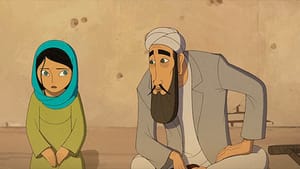Stay in the Loop
BSR publishes on a weekly schedule, with an email newsletter every Wednesday and Thursday morning. There’s no paywall, and subscribing is always free.
Hiding in plain sight
‘The Breadwinner,’ directed by Nora Twomey

The United States lags behind the rest of the world when it comes to its opinion of animation. Case in point: The Breadwinner, a new animated feature financed by Cartoon Saloon, an international consortium that includes entities from Ireland, Canada, and Luxembourg.
In the U.S., animation is considered appropriate mostly for frothy entertainment, children’s stories, and superhero tales. Elsewhere, animation is a worthwhile tool for telling sophisticated, meaningful stories that illuminate life and the human condition.
The Breadwinner (whose executive producers include Angelina Jolie) is based on Canadian author Deborah Ellis’s children’s novel, which she researched firsthand in Afghanistan in the late 1990s. Directed by Nora Twomey, the movie follows Parvana, a young girl who must disguise herself as a boy to provide for her family. The disguise is necessary because, under the country's oppressive Taliban rule, women and girls are not allowed out in public unless accompanied by a husband or a male member of the family, and must be shrouded in a full burqa.
Parvana’s disabled father teaches his daughter the value of storytelling and the power of imagination. However, he is arrested for annoying an irascible Taliban member. When Parvana sets out to reunite her family, she learns her father’s lessons weren’t only a source of solace from a difficult life but a fount of real-world strategy.
The story is enhanced by effective animation, headed by Sandra Norup Andersen and Fabian Erlinghauser. They have adopted a simple yet elegant style reminiscent of children’s-book illustration. This is not to say that the imagery is simplistic — quite the contrary. The characters are so expressive that we immediately identify with them as people who draw us into the story, as the best illustration does. The film's beautiful Middle Eastern design depicts both gritty Afghan cityscapes and the lovely Arabian Nights landscapes we see when Parvana tells one of her magical stories. These offer a sense of place, in terms of the natural, and a glimpse of the world as Parvana imagines it.
"These people do these things"
Ellis's novel contained serious reportage about life in Afghanistan. It was oppressive for everyone, to be sure, but particularly so for women and girls. Women were considered the virtual slaves of men, and any women caught in public unaccompanied could be beaten half to death on the spot. Women were also denied education. We are keenly aware of what Parvana and her family risk when she takes up her disguise and sets out in search of her father.
The members of the Taliban Parvana encounters are brutal bullies, so simplistically bad at first they seem like cardboard villains — except there are examples on the news of religious extremists behaving just as badly. This is a cartoon, but not an exaggeration. People do these things.
But even under the most repressive regimes, people do good things, too. Through courage and imagination, and with the help of a few good people she meets, Parvana learns hope can be sustained through dark times.
Though based on a children’s novel, The Breadwinner is not a childish story. It is tough, honest, and sometimes brutally violent. It tells of the harsh life these people are born into, but with courage and lots of heart, it also shows how hope and love can survive even the Taliban.
What, When, Where
The Breadwinner. Based on a novel by Deborah Ellis, Nora Twomey directed. Opens December 2017. Philadelphia-area showtimes.
Sign up for our newsletter
All of the week's new articles, all in one place. Sign up for the free weekly BSR newsletters, and don't miss a conversation.
 Gary L. Day
Gary L. Day